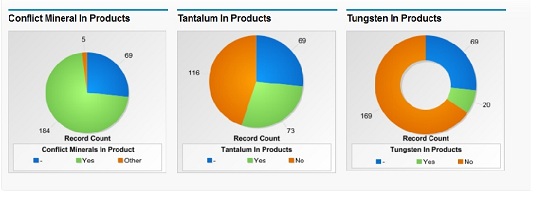Business Challenge Key Features Business Benefits
In United States, Section 1502 of the Dodd-Frank Act requires publicly traded US companies and certain other foreign companies must declare in their annual SEC filings whether they have Tantalum,
Tin, Gold or Tungsten (3TG) in their products, and if so whether these Conflict Minerals originate from mines fueling civil conflict in one of nine covered countries in Africa. While around 1200 US companies are directly required to file Conflict Minerals Report, the expected supply chain ripple requires as many as 12,000 US companies to perform some level of supply chain analysis.
Similary, in Europen Union, the new Battery Regulation 2023/1542 is requiring companies to perform
due diligence on battery minerals such as Cobalt, Nickel, Lithium and Natural Graphite.
Further profileration of world wide regulations, restrictions and evolving tariff landscape is forcing companies to identify sources of assortment of raw minerals.
In response, Responsible Minerals Initiative (RMI) has defined an assortment of Minerals Reporting Template(MRT) such as CMRT, EMRT and AMRT that companies should ask suppliers to fill out. However, manual approaches to managing responsible minerals traceability creates tremendous inefficiencies, not to mention the potential risk for error.
- Managing Supplier Requests and Responses: Companies must track which suppliers have been asked to provide a MRT, how many have received the request, how many have responded and which responses are past due. When this is manually managed through e-mail and spreadsheets, tracking this information becomes difficult.
- Validating Supplier Responses: When suppliers respond with the MRT spreadsheet, validating supplier response can be difficult. In our experience, 90% of templates have errors. One must validate that suppliers have responded to all mandatory questions and that the response is logically consistent. For example, a supplier should not specify Tungsten smelters if they declare that they have no Tungsten in their products.

- Analysis and Reporting: Without proper analysis and roll-up tools, companies must manually collate supplier responses to sift for answers for their regulatory filing or customer request reports. Answering a simple question such as "How many suppliers have Tantalum in products and who are they" can require extensive manual work. Answering more complex questions such as "What is the unique list of non-certified smelters and which suppliers use them?" can be daunting.
- Building Expertise and Staffing RCOI/Due Diligence efforts: Companies are struggling to build expertise in Responsible Minerals and staffing resources that can reach out suppliers and more importantly make sense of their response and perform due diligence.
- Managing Supply Chain Changes: As your suppliers change and your supplier's suppliers change, it becomes clear that Responsible Minerals management is an on-going activity - not a one time exercise. E-mail and spreadsheet based methods start appearing even more inefficient and risk prone.

